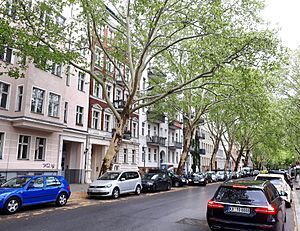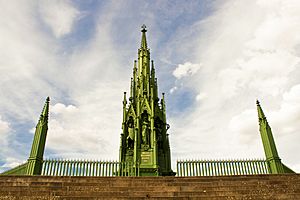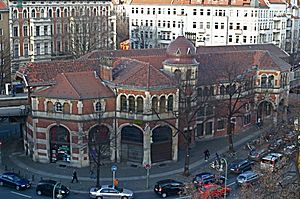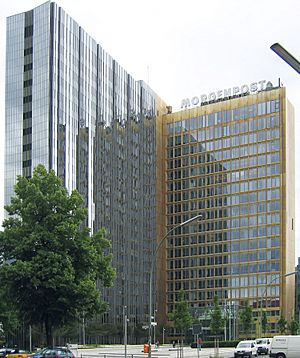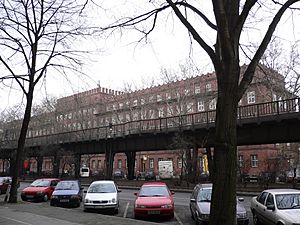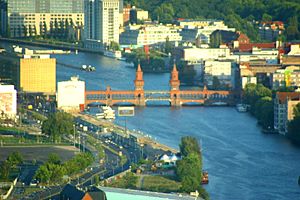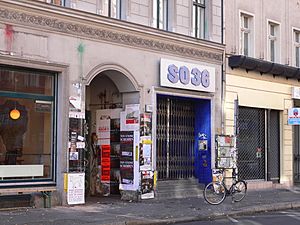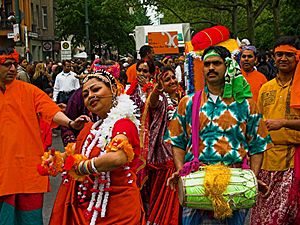Kreuzberg facts for kids
Quick facts for kids
Kreuzberg
|
||
|---|---|---|
|
Quarter of Berlin
|
||

Aerial photo
|
||
|
||
| Country | Germany | |
| State | Berlin | |
| City | Berlin | |
| Borough | Friedrichshain-Kreuzberg | |
| Founded | 1920 | |
| Elevation | 52 m (171 ft) | |
| Population
(2016-06-30)
|
||
| • Total | 153,887 | |
| Time zone | CET/CEST (UTC+1/+2) | |
Kreuzberg is a lively district in Berlin, Germany. It is part of the Friedrichshain-Kreuzberg area, located south of Berlin's city center, Mitte. The Spree River borders Kreuzberg to the east. The Landwehrkanal (a canal) flows through Kreuzberg from east to west, with a nice path called Paul-Lincke-Ufer running alongside it.
You can also find the old U-Bahn (subway) line U1 here. Other well-known spots include Görlitzer Park and Viktoriapark, which is on the side of the Kreuzberg hill.
During the Cold War (a time of tension between the Soviet Union and its allies, and the United States and its allies), Kreuzberg was one of the poorer parts of West Berlin. After German reunification in 1990, when East and West Germany became one country again, the area improved a lot. Today, it's famous for its art scene and diverse culture.
Kreuzberg is known for having many immigrants and their families, especially people of Turkish background. Even though it's a popular and diverse place, some parts of Kreuzberg still have higher unemployment rates and lower average incomes compared to other areas in Berlin.
History of Kreuzberg
Unlike many other parts of Berlin that used to be small villages, Kreuzberg has a shorter history. It was officially formed on October 1, 1920. This happened because of the Greater Berlin Act, which brought many suburbs into Berlin and created new areas called boroughs.
The name "Kreuzberg" means "cross hill." This hill is the highest point in the area, standing about 66 meters (217 feet) above sea level. For a long time, the hill was a popular spot for weekend trips.
The district got its name from the Prussian National Monument for the Liberation Wars. This monument was built in 1821 by Karl Friedrich Schinkel inside Viktoriapark. It honors the Napoleonic Wars. Before the 1800s, most of Kreuzberg was very rural, except for its northern part called Friedrichstadt.
Things changed in the 1860s when Berlin grew quickly due to new factories. Many of Kreuzberg's buildings were constructed during this time. They were built on streets planned out in the Hobrecht-Plan, creating an area known as the Wilhelmine Ring.
For a long time in the 20th century, Kreuzberg was the most crowded of Berlin's boroughs. It had over 400,000 people, even though it was (and still is) the smallest area. This meant it had a very high population density, with many people living close together.
Besides homes, Kreuzberg was also a center for Berlin's industries. The "export quarter" along Ritter Street had many small businesses. The "press quarter" along Koch Street was home to most of Germany's big newspapers and book publishers.
Sadly, both of these industrial areas were almost completely destroyed by air raids during World War II, especially on one night in February 1945. To remember its past, the Axel Springer press company built its German headquarters on Kochstraße again, right next to where the Berlin Wall used to stand.
After World War II, laws controlled how much rent could be charged in Kreuzberg. This made it less appealing for people to invest in fixing up homes. So, the housing was often not great quality, but it was cheap. This made Kreuzberg a popular place for immigrants coming to Germany and Berlin.
From the late 1960s, more and more students, artists, and immigrants moved to Kreuzberg. Since the Berlin Wall surrounded it on three sides, the area became known for its unique and alternative lifestyle. Many people, especially in the SO 36 part of Kreuzberg, lived in squatted buildings. Starting in 1987, there were large protests and gatherings in SO 36 on Labour Day.
After the Berlin Wall fell, Kreuzberg was suddenly back in the middle of the city. The cheap rents and many old 19th-century buildings made some parts of the area attractive to a wider range of people, including those with more money. Today, Kreuzberg has one of the youngest populations among European city areas.
In 2001, Berlin changed its administrative areas. Kreuzberg was combined with Friedrichshain to form the new borough of Friedrichshain-Kreuzberg. These two areas are only connected by one bridge over the Spree River, the Oberbaumbrücke. Because they couldn't agree on where to put the new city hall, they decided by flipping a five-Mark coin! The current city hall is in Friedrichshain.
Culture in Kreuzberg
Kreuzberg has always been a key place for Berlin's punk rock music and other alternative cultures in Germany. The SO36 club is still a very important part of Berlin's music scene. In the 1970s, it focused on punk music and was often visited by famous musicians like Iggy Pop and David Bowie. Back then, the club was considered one of the best new-wave music venues in the world.
There has also been a big influence from African-American and hip hop culture on the young people in Kreuzberg. The area has become a center for rap and breakdance in Berlin. Even though most people in Kreuzberg are of German or Turkish background, some feel more connected to American or African-American culture. Hip hop was mostly brought to Kreuzberg's youth by the children of American soldiers who were stationed nearby until Germany was reunified.
The Carnival of Cultures is a big festival held every year. It celebrates different cultures and backgrounds with colorful street parades and parties. You can enjoy street entertainment, food, arts and crafts stalls, music, and art.
Kreuzberg has also been a central place for LGBTQ+ (lesbian, gay, bisexual, transgender, queer) life and arts in Berlin. It is home to the Schwules Museum, which was started in the 1980s. This museum works to save, show, and discover queer history, art, and culture.
Images for kids
-
Saarlandstraße (today's Stresemannstraße) looking towards "Askanischer Platz" with the ruin of Anhalt Station and the tower stump of the "Protestant Saint Luke's Church", after the air raids during World War II
See also
 In Spanish: Kreuzberg para niños
In Spanish: Kreuzberg para niños



